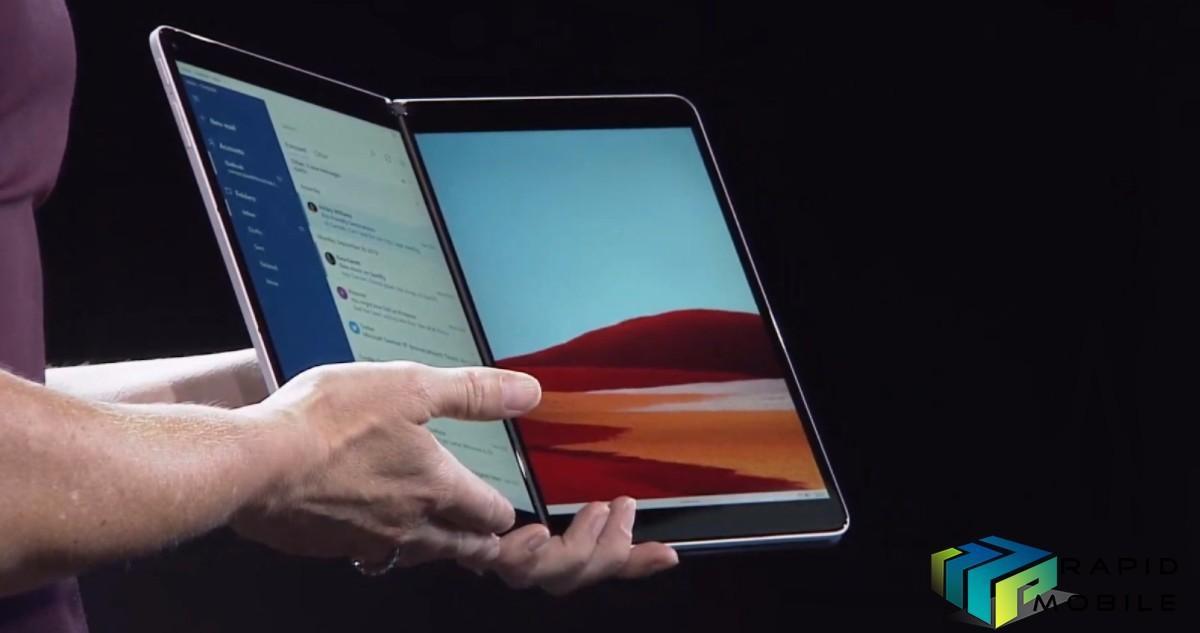Not only did Microsoft unveil the Surface Duo dual-screen Android phone and Windows 10X software for dual-screen devices today, the company is adding to its Surface lineup of PCs a device with dual 9-inch displays called the Surface Neo.
Weighing 1.4 pounds (655 grams) and 5.6mm thick, the Surface Neo uses the thinnest LCDs ever created, said Microsoft Chief Product Officer Panos Panay. Attached with 360-degree hinges, the displays have more than 60 microcoaxial cables running between the hinges, each thinner than a human hair.
The two displays expand to the dimensions of a 13.1-inch display with an 8.9mm seam. The Surface Neo will run on a new version of Windows 10 called Windows 10X that was designed and optimized for dual-screen devices.
Surface Neo is a dual-screen device that can be used to run multiple apps side-by-side and has a smaller Surface Pen that magnetically attaches to the back of the Gorilla Glass design. When it’s attached to the rear glass panel, the pen charges. So you won’t have to worry about fiddling around with AAA batteries, unlike the Surface Pen that ships with the Surface Laptop 3 and Surface Pro 7.
There’s also a keyboard attachment that can be overlaid onto one of the displays to help with typing. In a demo, Microsoft showed the foldable two-screen device resting on a tabletop like a laptop, with the keyboard accessory on the bottom display.
However, the company also showed the keyboard detached from the screen and separately on a table. If you’re doing more serious work and need both displays available to you, this set-up gives you the most screen real estate.
And when you’re done, you can attach the keyboard attachment to the back of the device – just like the Surface Pen. And like the stylus, it will also charge wirelessly through the glass case.
So, you’ll only ever need to charge the Surface Neo – none of the accessories to keep powering through the day.
Each side of the device 5.6mm thin. Microsoft says this is possible because it boasts the thinnest LCD display that has ever been created. Like the rest of the Surface portfolio, the hinge is critically important here. The hinge on the Surface Neo can rotate 360°, so you can fold the device around onto itself, so that it lies flat on a, ahem, surface.
https://www.youtube.com/watch?v=fssZICsV4Rg
The latest addition to the Surface line-up will be powered by Windows 10 X, which has been designed to support dual-screen devices. For example, when you tap to launch an app, Windows will open-up the application on whatever display you initially invoked it. According to the company, that means users are invited to launch another app on the second screen to cross-reference between the two panels.
Of course, you can launch an application across both screens if you need to. To do that, you just need to drag the application window across the dual displays. Rotating the device, the Surface Neo will automatically re-adjust the apps so that they’re orientated in the right direction.
Microsoft also said it needed developers to create software designed to work with the new form-factor – something that’s likely to take time. By announcing it early, those applications will likely be ready in time for launch.
“It’s a new expression of Windows 10 that we’ve been designing and building for the last couple of years, with hundreds of engineers and designers at Microsoft,” said Carmen Zlateff, Microsoft Program Manager for Experiences and Devices.
“Our goal is to fuel a new era of mobile productivity and creativity across two screens.”



